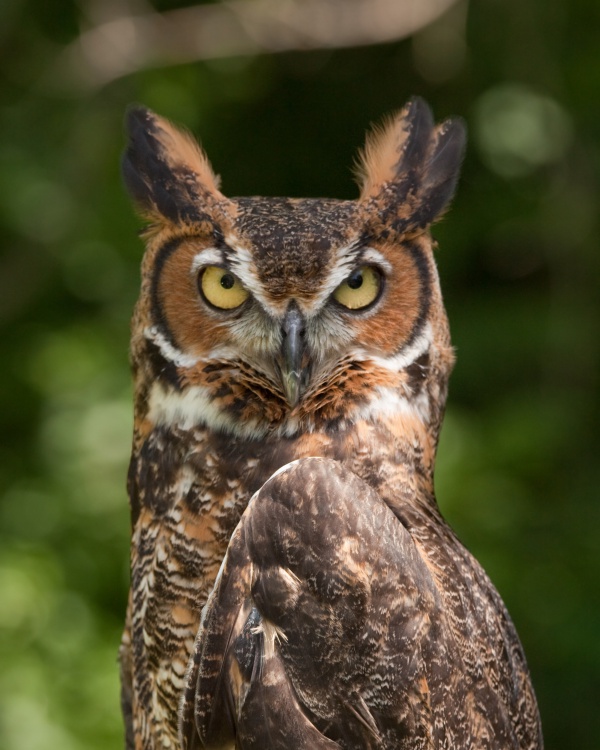Facts About Great horned owl
The great horned owl, often referred to as the tiger owl or hoot owl, is a large and adaptable bird native to the Americas. It is the most widely distributed true owl in this region. These owls have a diverse diet, primarily preying on rabbits, hares, rats, mice, and voles. However, they are versatile hunters and can catch a variety of other animals, including mammals, birds, reptiles, amphibians, and invertebrates. They are often compared to the Eurasian eagle-owl and the red-tailed hawk because they share similar habitats and ecological niches.
Description
Great horned owls are masters of camouflage. They feature light underparts with brown horizontal barring and mottled brown upper parts with intricate dark markings. Look for a variable-sized white patch on their throat and feathered legs and feet—the second-longest feathering of any owl species. Their facial disc can be reddish, brown, or gray, surrounded by a dark rim, and they sport distinctive feather tufts known as plumicorns. Their bill and talons are a dark gunmetal-gray.
Physiology and Measurements
These owls are the heaviest owl species in Central and South America and the second heaviest in North America. Their size varies depending on the region, with the largest populations found in interior Alaska and Ontario. Adult great horned owls range from 43 to 64 cm in length, with a wingspan of 91 to 153 cm. Females are generally larger than males. Thanks to their unique wing structure, they can fly silently and at low speeds.
Calls
Their song is a low-pitched, loud hooting sequence. Males and females have different calls, with females typically having higher-pitched calls. They also make various sounds when disturbed or during courtship.
Species Identification
You can identify a great horned owl by its size, ear tufts, and barred plumage. It is sometimes confused with the lesser or Magellanic horned owl, but these are smaller and have finer barring.
Taxonomy
The great horned owl belongs to the genus Bubo, which includes about 25 other species, mainly in Africa. It may be closely related to the Eurasian eagle-owl and the snowy owl, with the latter being its closest living relative.
Subspecies
There are over 20 named subspecies, but many are just variations in color and size. Notable subspecies include the common/eastern great horned owl (Bubo virginianus virginianus), the South American great horned owl (Bubo virginianus nacurutu), and the northern/sub-Arctic great horned owl (Bubo virginianus subarcticus).
Distribution and Habitat
Great horned owls are found from the subarctic regions of North America to upland areas of South America. They thrive in diverse environments like forests, deserts, mountains, and urban areas, although they avoid extreme deserts and rainforests.
Behavior
These owls are mostly nocturnal and rely on their excellent camouflage to roost during the day. They are highly territorial and often remain in the same area for life. They hunt by watching from perches and diving to ambush their prey.
Reproduction
Great horned owls are among the earliest nesting birds in North America, often laying eggs in late winter. They don't build their own nests but take over those built by other large birds. The female incubates the eggs while the male provides food.
Mortality and Longevity
These owls can live up to 13 years on average, with some living much longer. They face threats from human activities such as vehicle collisions and poisoning from pest control substances. Natural predators are few, but their young can fall prey to various mammals and birds.
Conservation Impact
While great horned owls sometimes prey on endangered species, impacting conservation efforts for those species, they themselves are not considered globally threatened.
Cultural Significance
In Native American cultures, the great horned owl is often associated with strength, courage, and mystical powers. It is also the provincial bird of Alberta.

 United States
United States